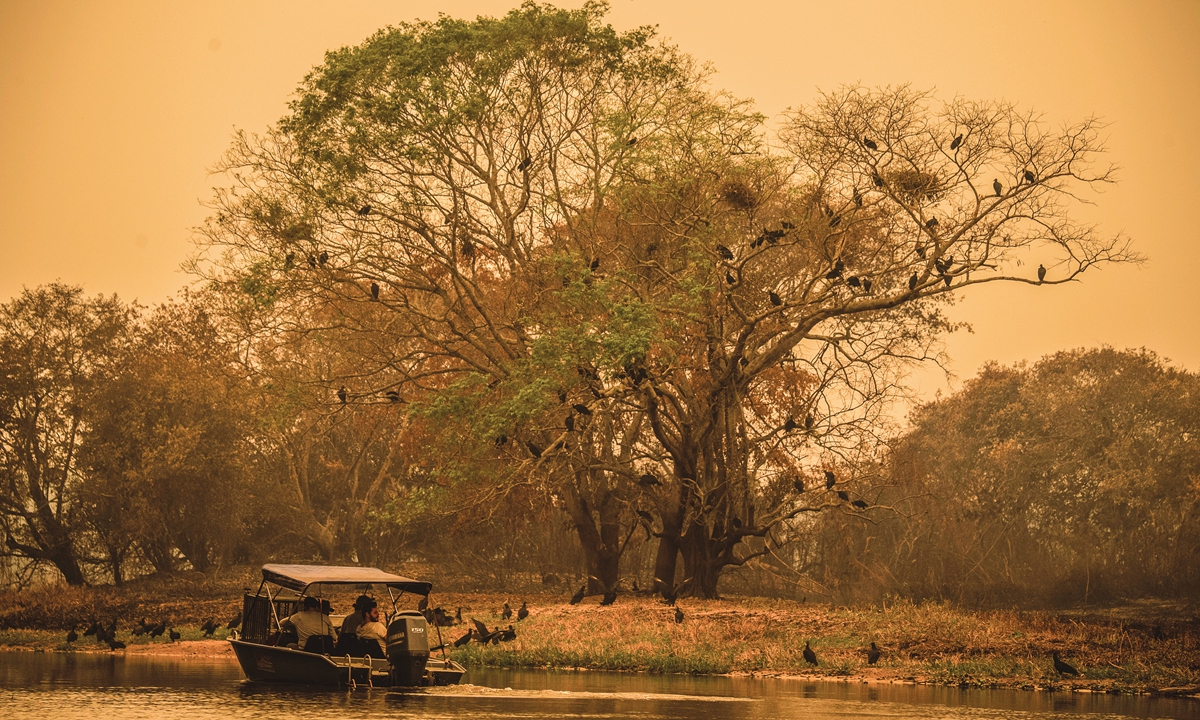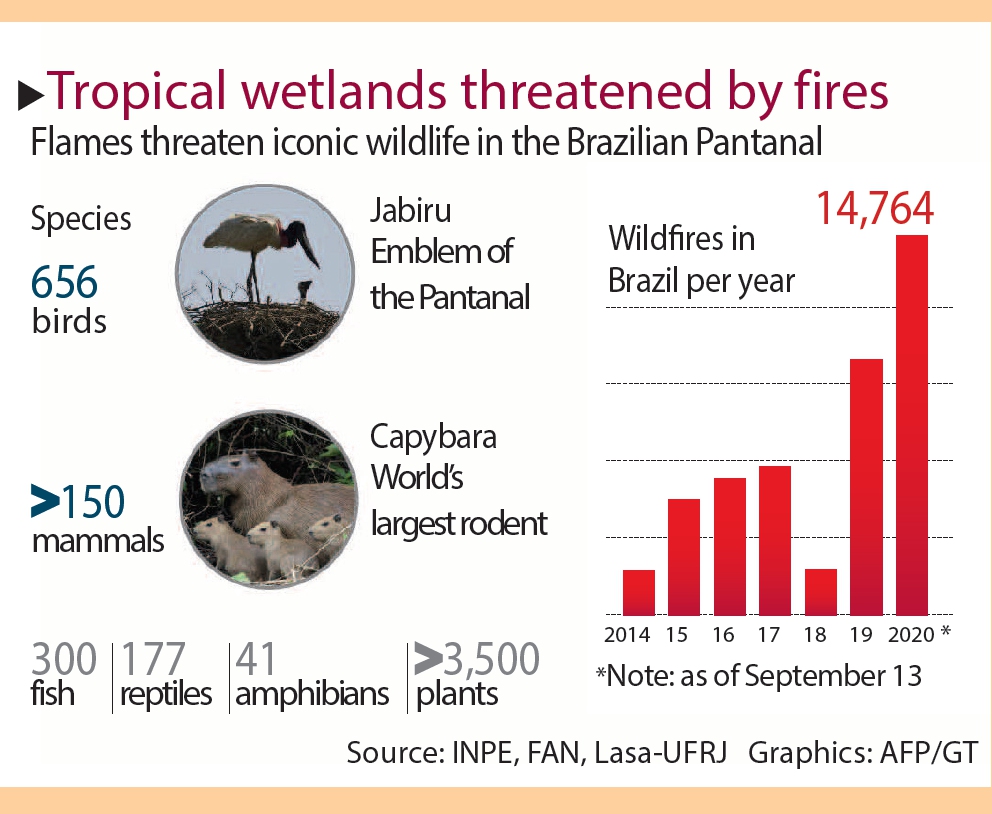Desperate race against fires in world's biggest tropical wetlands
Source: AFP Published: 2020/9/15 19:08:40
The smell of burnt vegetation and the red glow of flames welcome visitors these days to the Pantanal, the world's biggest tropical wetlands - a biodiverse paradise that is now partly reduced to ashes by record wildfires.
In the northern Pantanal, in central-western Brazil - a region that formerly had a thriving ecotourism industry - hotel employee Felipe Maia is hosing down a wooden bridge, hoping to stop the nearby flames from igniting it.

"Every day we drive along the road, check which bridge is closest to catching fire and douse it in water," Maia told AFP after soaking the bridge, just meters from the flames.
The Pantanal sits at the southern edge of the Amazon rainforest, stretching from Brazil into Bolivia and Paraguay.
In normal times, it draws tourists from around the world with its lush landscapes and wildlife, including jaguars, jabiru storks, giant otters, caimans, toucans, macaws and monkeys. But in 2020, around 23,500 square kilometers of the wetlands have gone up in smoke - nearly 12 percent of the Pantanal.
There have been a record-shattering 14,764 fires in the Brazilian Pantanal in 2020, according to satellite data from Brazil's National Space Research Institute (INPE).
In less than nine months, 2020 has already broken the annual record for the number of fires, according to INPE, with an increase of 214 percent from the same period in 2019.
"It's sad. Just when we thought tourism was about to bounce back from the coronavirus pandemic, these fires have destroyed 10 to 15 percent of the Pantanal," said tour guide Roberto Carvalho Macedo, part of an informal brigade of firefighters, residents, officials and hotel owners who have banded together to patrol the area's bridges day and night.

'Critical condition'
Fellow guide Eduarda Fernandes Amaral was traveling by boat up a river in Encontro das Aguas State Park, known as the home to the world's biggest jaguar population. She and a team of veterinarians and biologists
were looking amid the charred remains of trees and shrubs for a jaguar that had reportedly been wounded in a fire.
"All the animals we've rescued so far have been in critical condition. Some of them have died, some are burnt all the way to the bone," she said.
She set out drinking water and baskets of fruit for animals that survived the fires. They now risk dying of dehydration or starvation.
It is impossible to estimate yet how many animals have died, but she said she fears the losses are enormous.
"I hope this makes people open their eyes and understand that the biodiversity here is unique. We have to preserve it," she told AFP.

The scenes in the Pantanal are reminiscent of the wildfires devastating the US West Coast.
As with those fires, there is a complex web of factors driving the blazes.
The main cause in the Pantanal is drought.
From January to May, the usual rainy season, the region received just half the precipitation it normally does. As a result, many areas that are usually flooded this time of year are dry.
Exacerbating the problem, ranchers are increasingly introducing non-native plants for pasture land, weakening the region's natural resistance to fire, experts say.
Ecologists also blame funding and staffing cuts at Brazil's environmental protection agencies under far-right President Jair Bolsonaro, who took office in January 2019.
"There's a widespread sense of impunity" among farmers and ranchers who set fires to clear land for crops and pasture, said forestry engineer Vinicius Silgueiro of the Life Center Institute (ICV).
The crisis in the Pantanal has added to the criticism the Brazilian government faces over the Amazon.
There have been 62,627 fires in the Brazilian Amazon so far in 2020, an increase of 10 percent from the same period in 2019.
Newspaper headline: Scorched earth
In the northern Pantanal, in central-western Brazil - a region that formerly had a thriving ecotourism industry - hotel employee Felipe Maia is hosing down a wooden bridge, hoping to stop the nearby flames from igniting it.

Volunteers of an animal rescue group patrol look for an injured jaguar in the Pantanal, near the Transpantaneira park road, which crosses the world's largest tropical wetland on Sunday. Photos: AFP
There are scores of wooden bridges like this over the streams criss-crossing the wetlands along the dirt highway across the Pantanal, the 150-kilometer "Transpantaneira." But amid the region's worst drought in 47 years, many streams have run dry, and the fires often set this time of year on farms and ranches to clear land have spiraled out of control."Every day we drive along the road, check which bridge is closest to catching fire and douse it in water," Maia told AFP after soaking the bridge, just meters from the flames.
The Pantanal sits at the southern edge of the Amazon rainforest, stretching from Brazil into Bolivia and Paraguay.
In normal times, it draws tourists from around the world with its lush landscapes and wildlife, including jaguars, jabiru storks, giant otters, caimans, toucans, macaws and monkeys. But in 2020, around 23,500 square kilometers of the wetlands have gone up in smoke - nearly 12 percent of the Pantanal.
There have been a record-shattering 14,764 fires in the Brazilian Pantanal in 2020, according to satellite data from Brazil's National Space Research Institute (INPE).
In less than nine months, 2020 has already broken the annual record for the number of fires, according to INPE, with an increase of 214 percent from the same period in 2019.
"It's sad. Just when we thought tourism was about to bounce back from the coronavirus pandemic, these fires have destroyed 10 to 15 percent of the Pantanal," said tour guide Roberto Carvalho Macedo, part of an informal brigade of firefighters, residents, officials and hotel owners who have banded together to patrol the area's bridges day and night.

'Critical condition'
Fellow guide Eduarda Fernandes Amaral was traveling by boat up a river in Encontro das Aguas State Park, known as the home to the world's biggest jaguar population. She and a team of veterinarians and biologists
were looking amid the charred remains of trees and shrubs for a jaguar that had reportedly been wounded in a fire.
"All the animals we've rescued so far have been in critical condition. Some of them have died, some are burnt all the way to the bone," she said.
She set out drinking water and baskets of fruit for animals that survived the fires. They now risk dying of dehydration or starvation.
It is impossible to estimate yet how many animals have died, but she said she fears the losses are enormous.
"I hope this makes people open their eyes and understand that the biodiversity here is unique. We have to preserve it," she told AFP.

Giant otters (Ariranha) swim in the Pantanal, near the Transpantaneira park road on Sunday.
Causes and effectsThe scenes in the Pantanal are reminiscent of the wildfires devastating the US West Coast.
As with those fires, there is a complex web of factors driving the blazes.
The main cause in the Pantanal is drought.
From January to May, the usual rainy season, the region received just half the precipitation it normally does. As a result, many areas that are usually flooded this time of year are dry.
Exacerbating the problem, ranchers are increasingly introducing non-native plants for pasture land, weakening the region's natural resistance to fire, experts say.
Ecologists also blame funding and staffing cuts at Brazil's environmental protection agencies under far-right President Jair Bolsonaro, who took office in January 2019.
"There's a widespread sense of impunity" among farmers and ranchers who set fires to clear land for crops and pasture, said forestry engineer Vinicius Silgueiro of the Life Center Institute (ICV).
The crisis in the Pantanal has added to the criticism the Brazilian government faces over the Amazon.
There have been 62,627 fires in the Brazilian Amazon so far in 2020, an increase of 10 percent from the same period in 2019.
Newspaper headline: Scorched earth
Posted in: AMERICAS